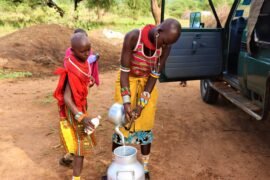Local Community Goat Milk
One of the main things that has made a big difference in being able to raise these small and vulnerable calves, and especially those with challenging injuries such as Lomunyak and Long’uro is the discovery of using a new milk formula which is far easier for the elephants to digest, extremely nutritious and best of all it is right under our trunks in the local community.
Thanks to the efforts of the keepers, co-founder Katie Rowe and the local community a plan to start using goats milk was formed, after research and sign off from vets and the Kenya wildlife service the new formula was tried with Sera, and since then has had 100% success rate with all seven calves.
Livestock plays an important sociocultural role for the Samburu people and the fact that it is their own livestock that is supporting the orphaned elephants health brings them that much closer to the project. Generally women concentrate on the lower levels of the livestock value chain as they take care of smaller, young and sick stock, they are responsible for milking and milk sales at a household level. Women often manage sheep and goats as they tend to be kept closer to the homestead. Women also tend to be left responsible for the home herd of cattle and camels when men take others herds on migration. As such, women‘s roles in livestock management is crucial.
As you can imagine we are extremely excited about this idea as not only does it empower the women in the local community who are traditionally the owners of the milk, but it is also supporting the community through milk sales when tourism is low, and finally the elephants are thriving on it! Livestock plays an important sociocultural role for the Samburu people and the link between their own livestock supporting the orphans has made the bond between the community and the elephants incredibly strong and a lot of pride for the project.




